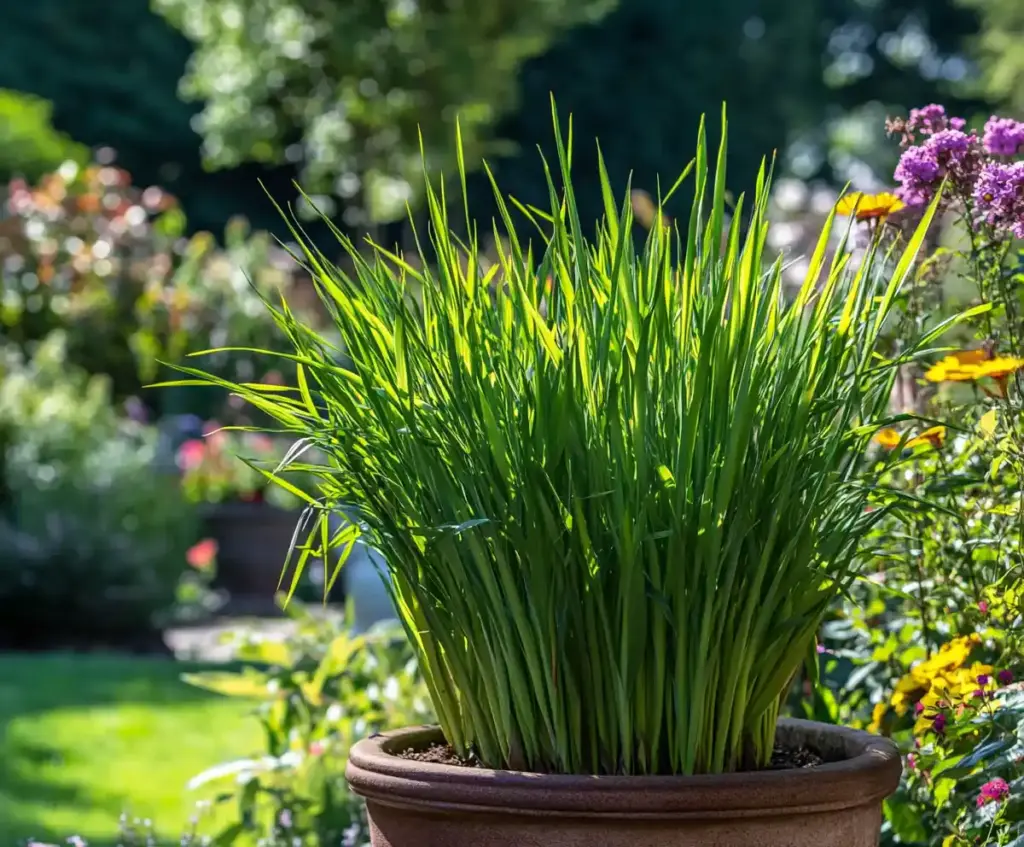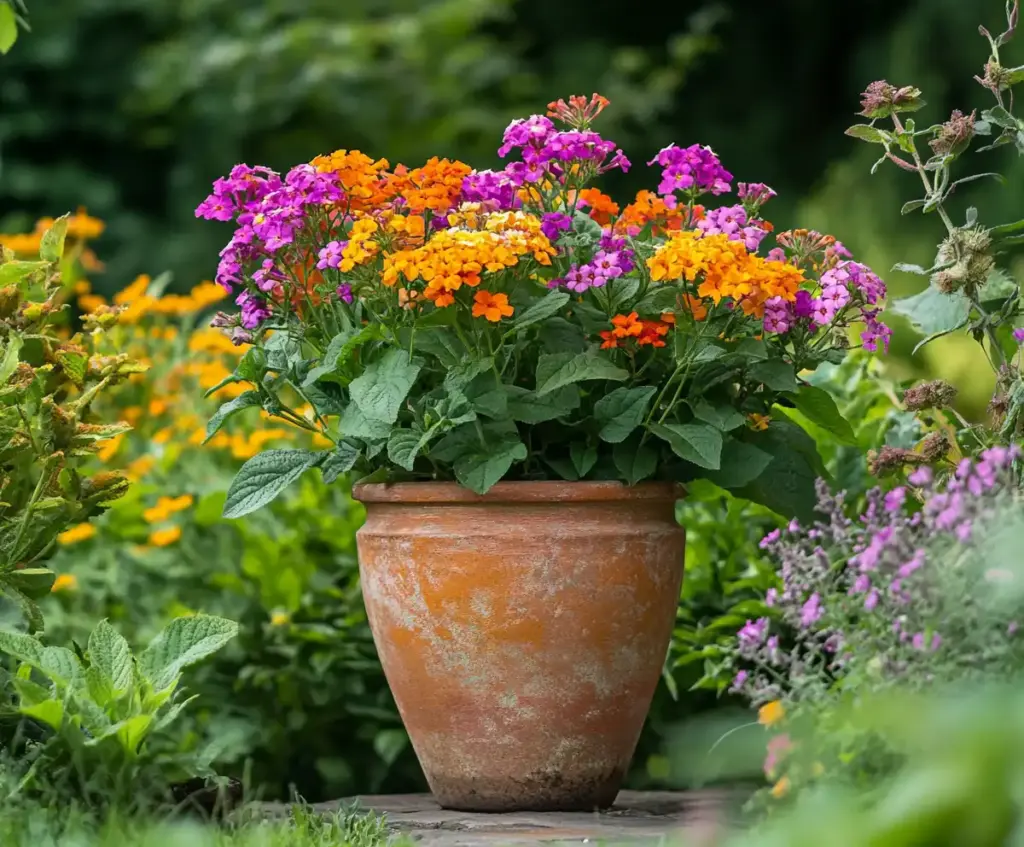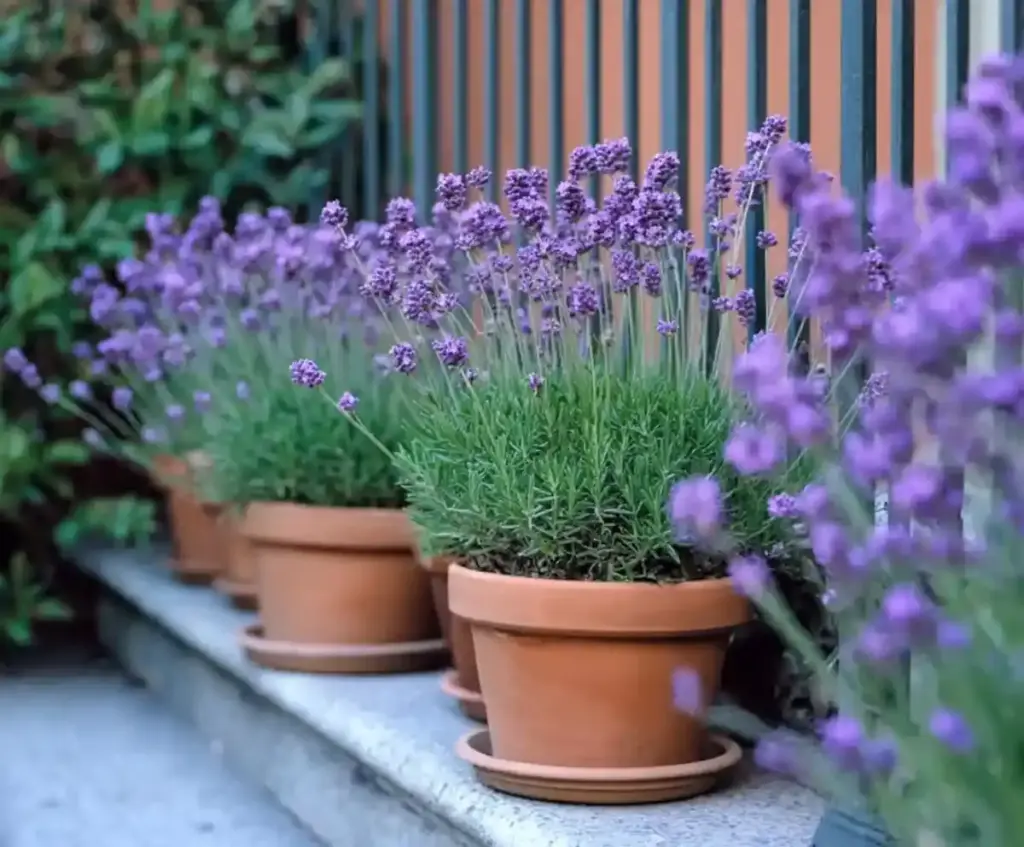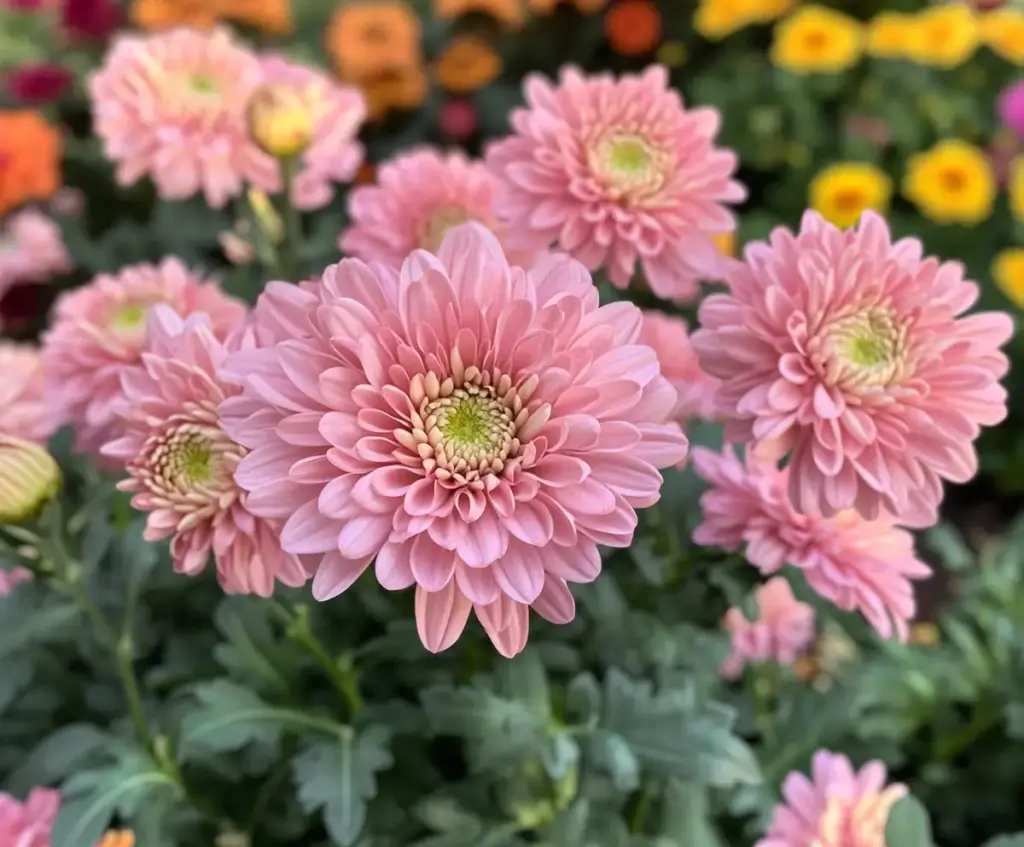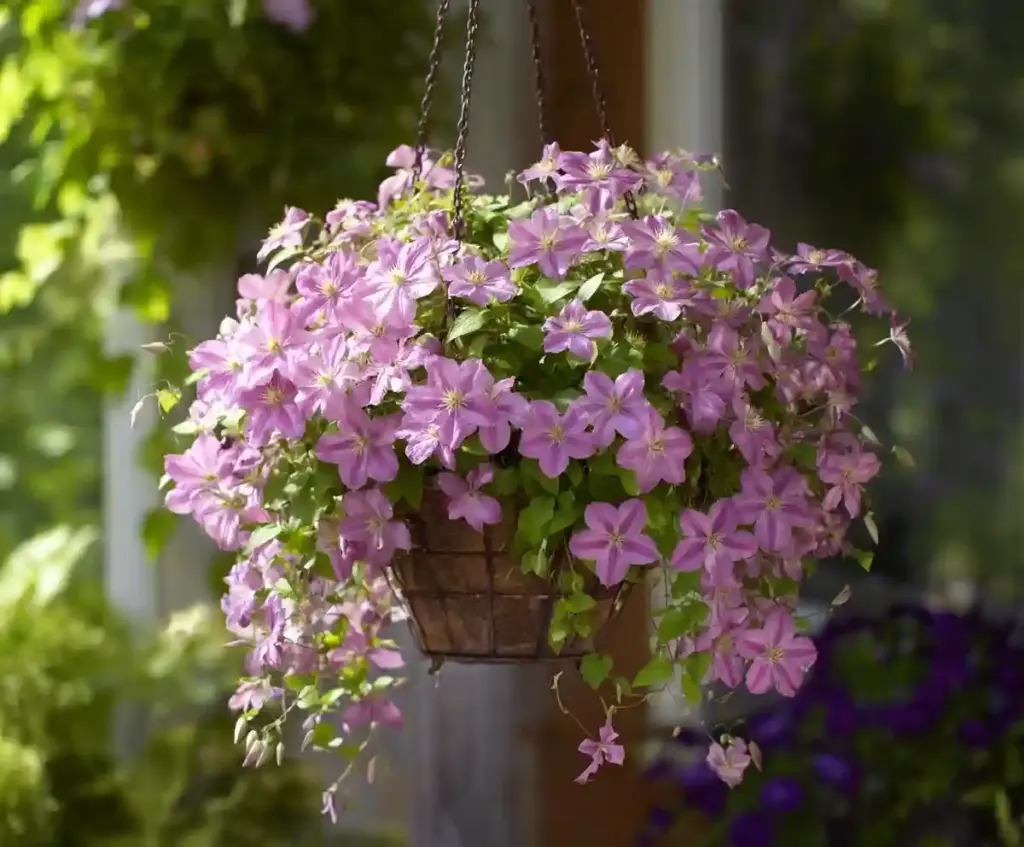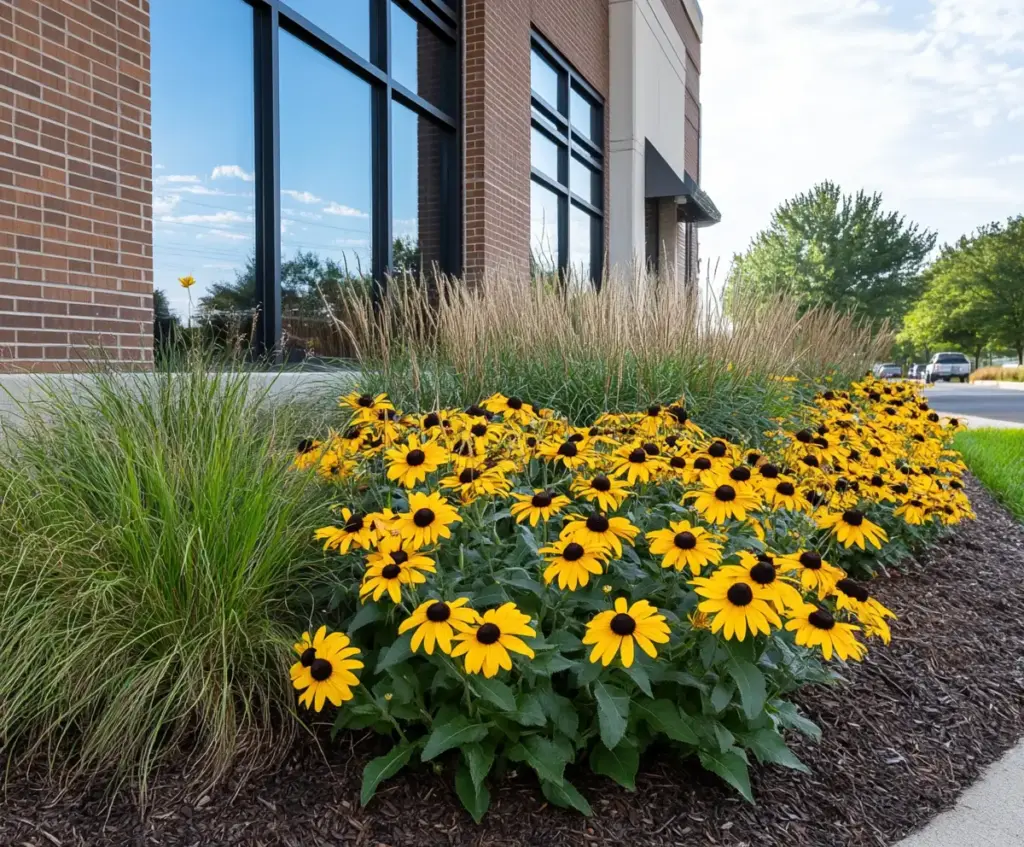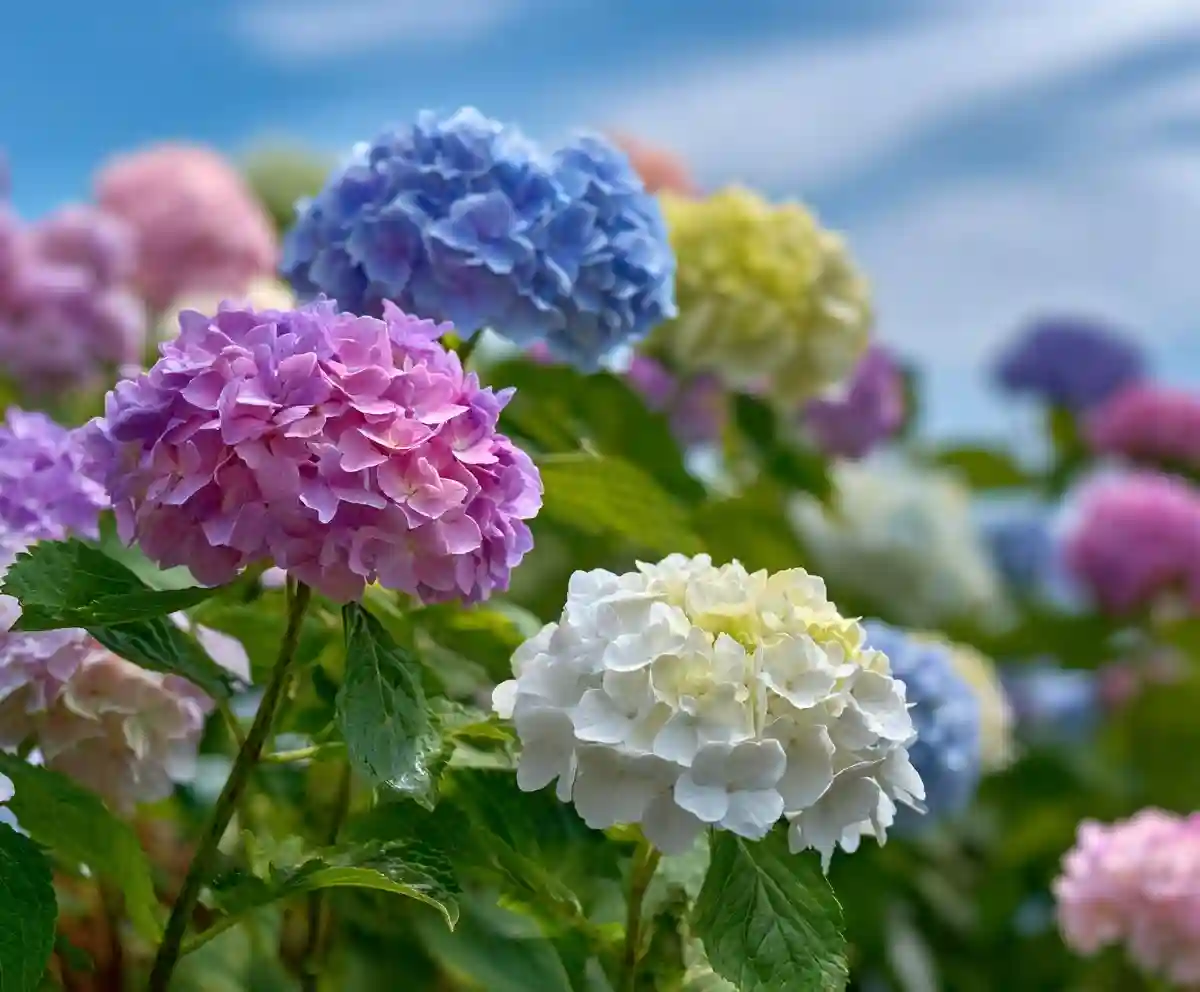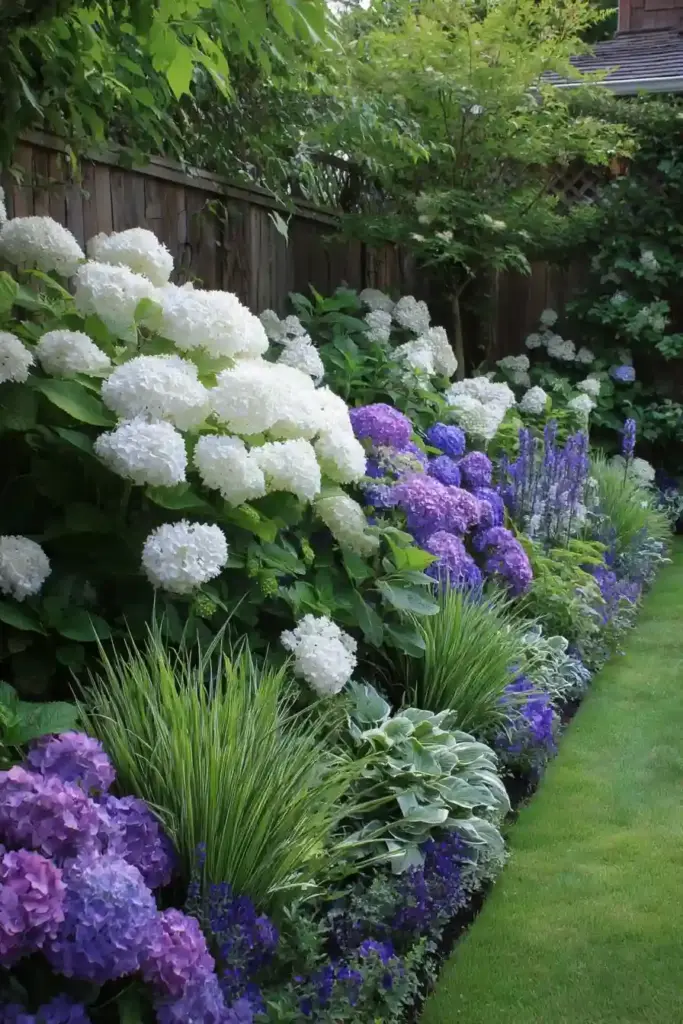Hydrangea landscaping ideas can breathe new life into any outdoor space, offering both vibrant color and graceful form. These lush flowering shrubs are cherished not only for their stunning seasonal blooms but also for their adaptability in various garden styles. Whether you’re creating a backyard retreat, a front yard showpiece, or a charming cottage-style path, hydrangeas lend themselves beautifully to countless creative arrangements.
From elegant borders and natural hedges to tranquil woodland settings and striking focal points, these ideas will help you transform your garden into a space that feels welcoming, expressive, and full of character. With the right approach, hydrangeas can elevate your landscape while remaining easy to maintain throughout the seasons.
Table of Contents
1. Hydrangea Border Garden
Creating a hydrangea border garden is a classic way to bring structure and elegance to your landscape. Whether lining a driveway, pathway, or property edge, the broad, vibrant blooms provide a soft yet striking visual boundary. Their consistent growth habit makes them ideal for shaping natural borders without needing rigid fencing or walls.
Opt for varieties like Hydrangea macrophylla for bold color or Hydrangea paniculata if you prefer conical blooms that hold up better in sunnier areas. Spacing is key—leave room for mature growth, typically 3–6 feet apart, depending on the cultivar. You can alternate bloom colors for a dynamic look or stick to a monochrome palette for a cleaner, more formal aesthetic.
For a polished finish, pair the border with mulch or decorative edging stones to suppress weeds and retain soil moisture.
2. Hydrangea and Evergreen Mix
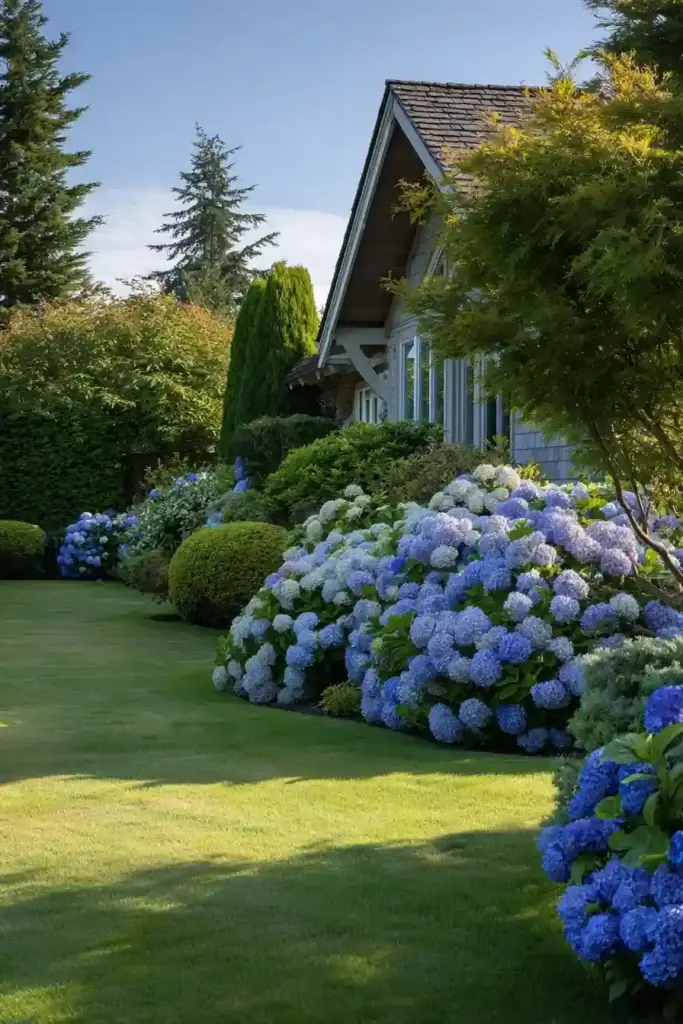
Blending hydrangeas with evergreens is one of the smartest hydrangea landscaping ideas for year-round visual interest. While hydrangeas shine during spring and summer with their dramatic blooms, evergreens like boxwood, juniper, or dwarf spruce maintain structure and color throughout the colder months.
This pairing ensures your garden never looks bare. Evergreens provide a solid green backdrop that enhances the bold hues of hydrangea flowers—especially blues, pinks, and whites. In winter, their dense foliage helps keep the landscape from feeling empty.
Plant hydrangeas slightly in front of evergreens for a layered effect. Choose compact evergreen varieties if you’re working with limited space, or use taller cultivars as privacy screens. This combination is particularly effective along foundations, garden borders, or around patios where consistent visual appeal is key.
3. Hydrangea Hedge

A hydrangea hedge is a beautiful way to create privacy while adding soft color and seasonal charm to your landscape. Unlike formal hedges that require constant trimming, hydrangeas offer a more relaxed, natural look with their rounded, voluminous blooms and lush green foliage.
This approach works well along property lines, between garden sections, or as a backdrop for flower beds. Varieties like Hydrangea paniculata ‘Limelight’ or Hydrangea arborescens ‘Annabelle’ are ideal for hedging due to their vigorous growth and long-lasting flowers.
Plant them close enough to touch at maturity—typically 3 to 5 feet apart—so their canopies blend into a continuous wall of blooms. For extra height and privacy, select taller cultivars and allow them to grow freely without frequent pruning.
A hydrangea hedge doesn’t just block views; it invites admiration.
4. Cottage Garden with Hydrangeas
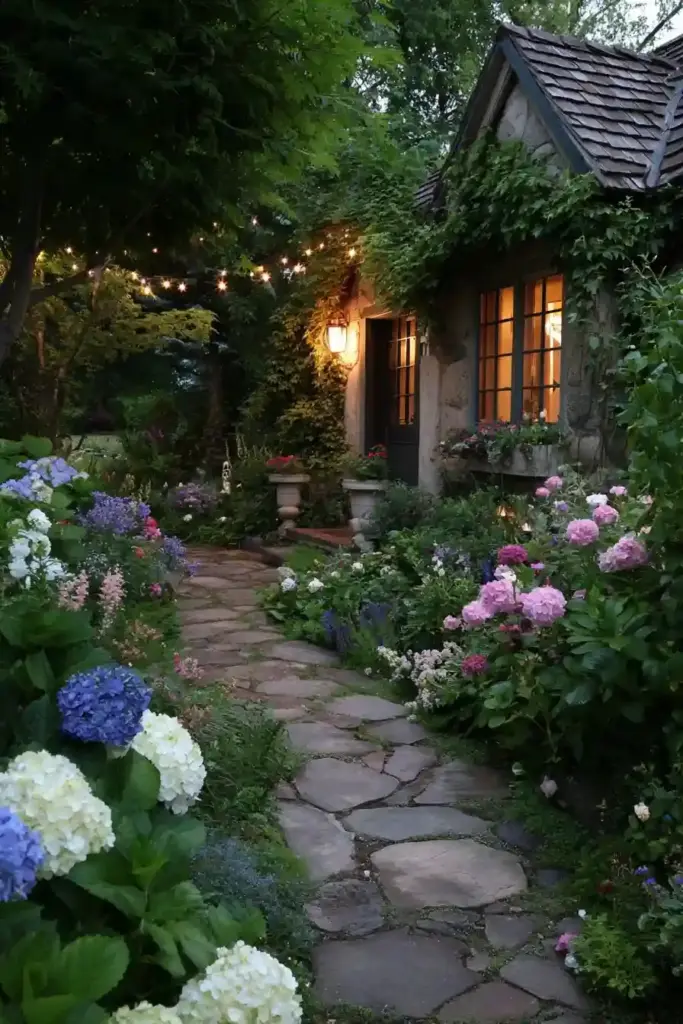
No plant fits a cottage-style garden quite like the hydrangea. Their old-fashioned charm, abundant blooms, and soft textures make them a perfect match for romantic, free-flowing landscapes full of life and color. This is one of the most inviting hydrangea landscaping ideas for gardeners who love a natural, whimsical aesthetic.
Combine hydrangeas with cottage favorites like roses, delphiniums, lavender, and catmint. The goal is not rigid structure but harmonious chaos—clusters of blooms spilling over paths, framed by rustic fences or winding borders.
Choose mophead or lacecap varieties in pastel shades for a classic English garden vibe. Leave room for self-seeding annuals, and don’t be afraid to let the garden grow a bit wild. The informal mix of textures and heights is part of the charm.
This approach creates a space that feels both timeless and personal, where every bloom tells a story.
5. Hydrangea Woodland Garden
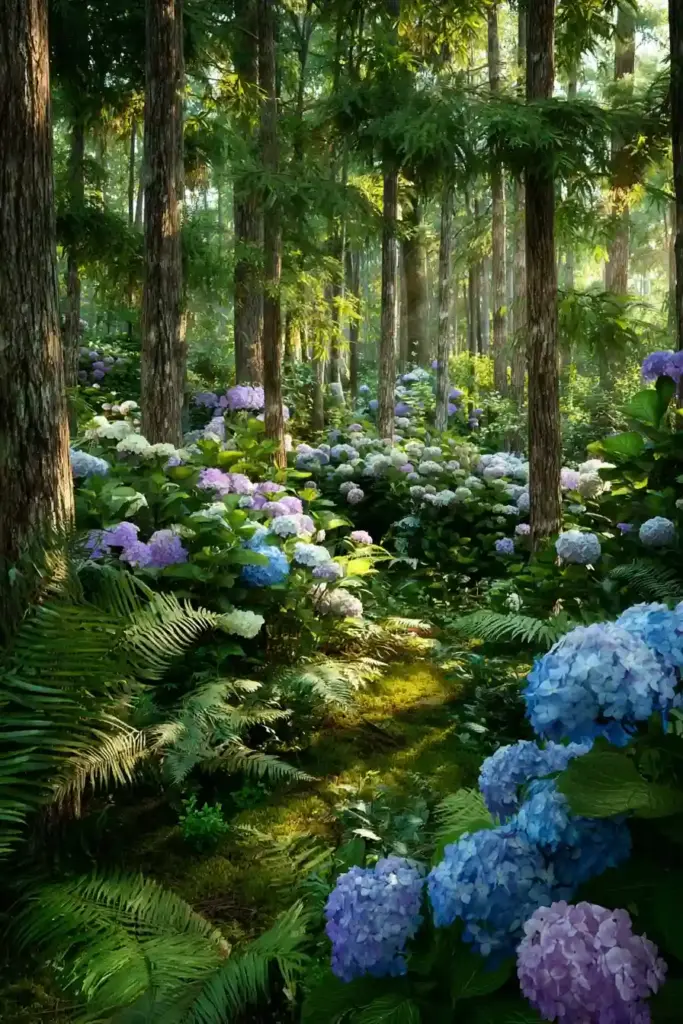
Designing a hydrangea woodland garden is a brilliant way to bring color and life to shady or partially shaded areas. Many hydrangea varieties—especially Hydrangea serrata and Hydrangea macrophylla—thrive in dappled light, making them ideal companions for forested or tree-lined gardens.
Nestle them among ferns, hostas, astilbes, and other shade-loving perennials to create a layered, serene environment. The contrast between the hydrangeas’ bold blooms and the finer foliage of woodland plants adds texture and depth without overwhelming the space.
Mulch generously to retain moisture and mimic the forest floor, and use natural elements like fallen logs or mossy stones to enhance the rustic appeal. A curved path or stepping stones winding through the plantings can complete the immersive woodland feel.
This is one of the most peaceful hydrangea landscaping ideas, perfect for quiet reflection or a cool escape on hot summer days.
6. Hydrangeas Around a Gazebo
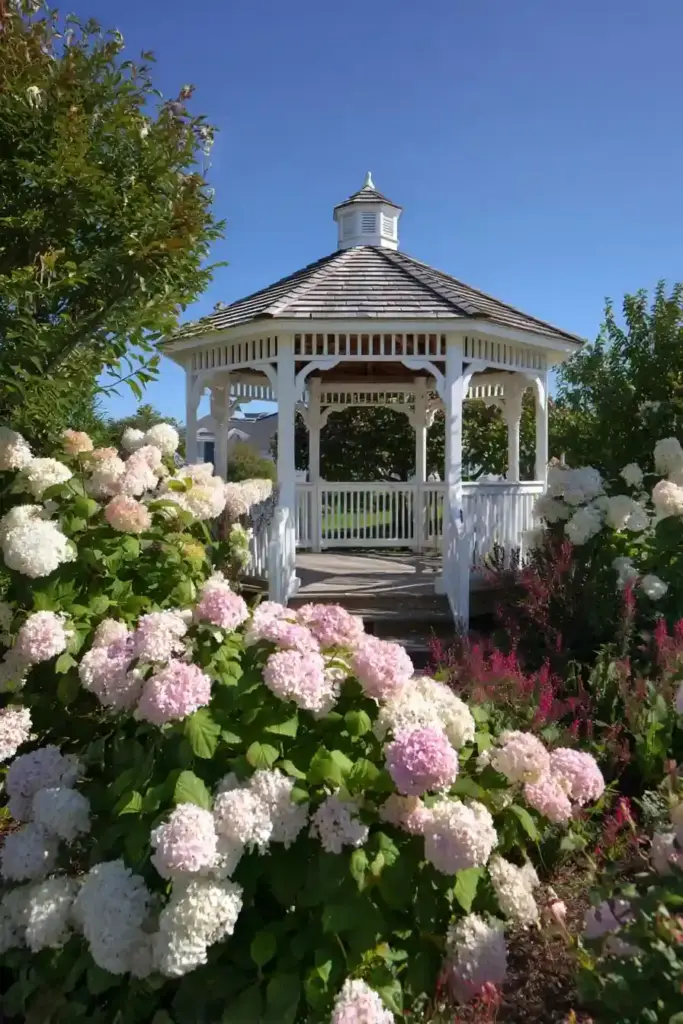
Planting hydrangeas around a gazebo creates a picture-perfect garden centerpiece that feels inviting, romantic, and thoughtfully designed. The bold, blooming shrubs soften the gazebo’s architectural lines while drawing attention to the structure as a focal point in the landscape.
Choose varieties like Hydrangea paniculata for sun-drenched spots or Hydrangea macrophylla for areas with partial shade. Plant them in clusters along the gazebo’s base, leaving space for air circulation and maintenance access. For extra visual appeal, add low-growing plants like salvia, liriope, or groundcovers around the hydrangeas to fill in the lower layers.
Consider including climbing hydrangeas (Hydrangea anomala subsp. petiolaris) if your gazebo has trellised sides or posts. These vines produce delicate lace-like blooms and can elegantly trail or climb with minimal support.
This layout not only enhances the beauty of your gazebo but also turns it into a dreamy garden retreat.
7. Potted Hydrangeas on a Patio
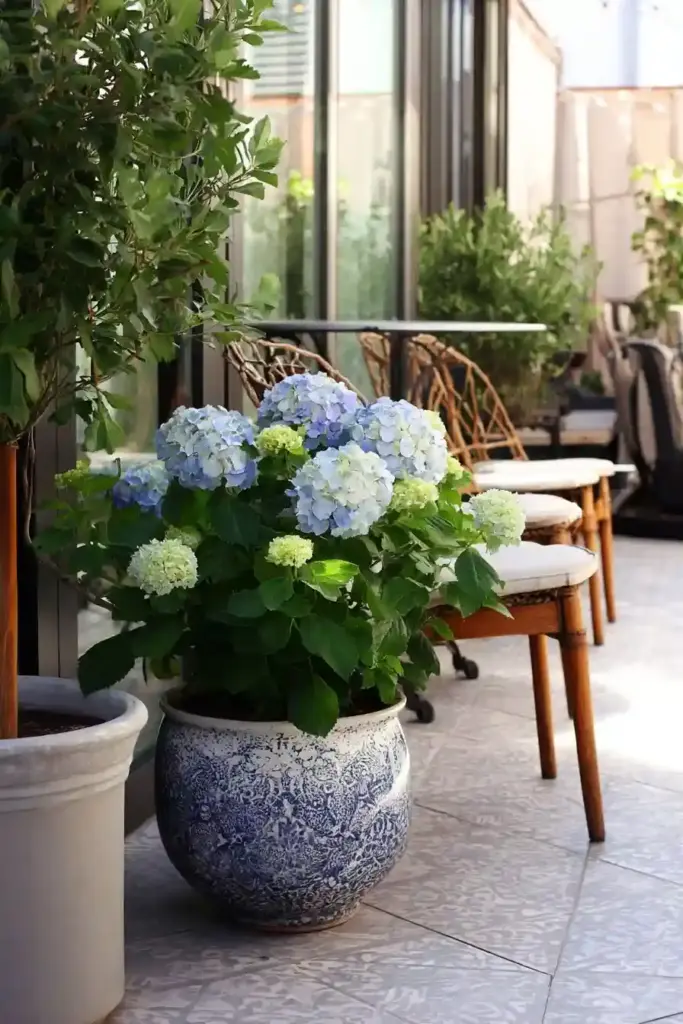
For those working with smaller outdoor spaces, potted hydrangeas on a patio offer a flexible and visually stunning way to bring blooms right up to your doorstep. This is one of the most practical hydrangea landscaping ideas for renters, apartment dwellers, or anyone looking for easy, movable beauty.
Select compact varieties like Hydrangea macrophylla ‘Mini Penny’ or Hydrangea paniculata ‘Bobo’ that thrive in containers without becoming too large. Use pots with excellent drainage and rich, well-aerated soil. Water consistently—container plants dry out faster than those in-ground—and position them where they’ll receive morning sun and afternoon shade.
Group multiple pots of varying heights for a layered effect, or flank entryways and seating areas with matching containers for symmetry. In colder climates, you can even move the pots indoors or to a sheltered area in winter to protect them from harsh frost.
This approach adds seasonal charm to patios, balconies, and porches with very little effort.
8. Hydrangea and Rose Combination
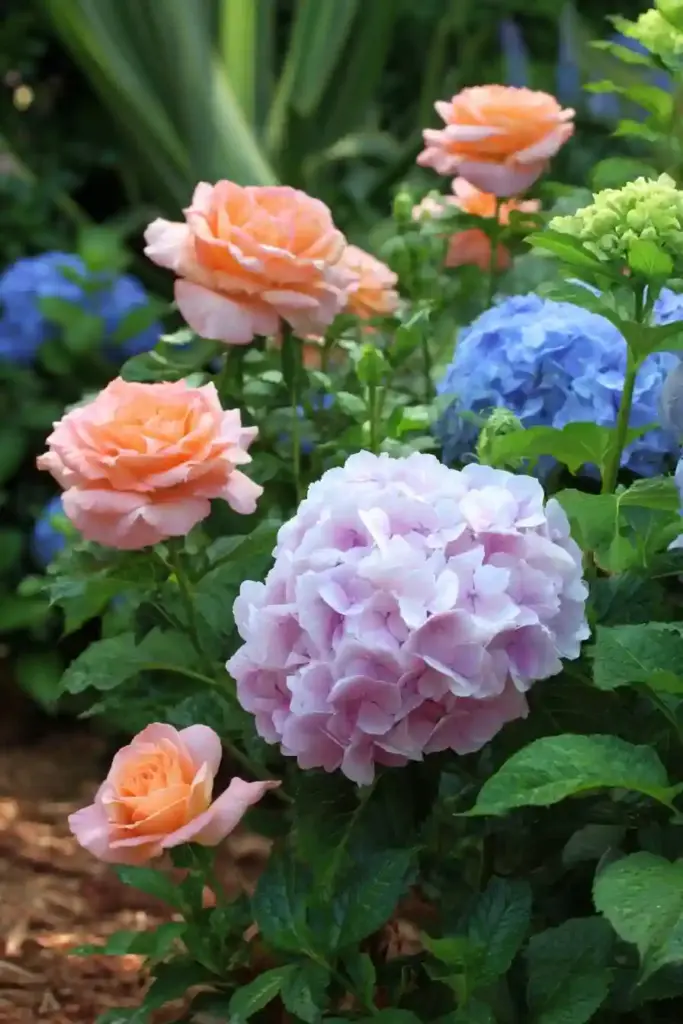
Pairing hydrangeas with roses results in a timeless garden scene bursting with texture, color, and elegance. These two powerhouse bloomers complement each other beautifully—roses bring structure and fragrance, while hydrangeas offer volume and a softer touch.
This is one of the most refined hydrangea landscaping ideas for gardeners who want a lush, layered effect. Choose roses that match your climate—shrub roses, climbing roses, or floribundas—and plant them with Hydrangea arborescens or Hydrangea macrophylla for a stunning contrast in both form and bloom shape.
Ensure proper spacing to allow airflow and prevent disease. Roses prefer full sun, so pick a location where the hydrangeas get morning sun and afternoon shade—ideal for both.
To unify the look, intersperse filler plants like nepeta, salvia, or lady’s mantle at the base. This pairing brings an old-world charm and works wonderfully in cottage gardens, formal borders, or along fences and trellises.
9. Hydrangea Focal Point in a Circular Bed

Designing a hydrangea focal point in a circular bed is a smart and stylish way to anchor your garden with visual impact. The symmetrical shape naturally draws the eye, while the hydrangeas’ lush blooms provide a bold centerpiece that changes with the seasons.
Place a single large hydrangea shrub—such as Hydrangea ‘Incrediball’ or Hydrangea paniculata ‘Phantom’—in the center, or cluster several smaller ones for a fuller look. Surround them with a border of contrasting low-growing plants like coral bells, alyssum, or boxwood for added structure and variety.
This layout works particularly well in front yards, open lawns, or at the intersection of garden paths. Mulch the bed generously to conserve moisture and enhance the visual definition of the circle.
Among the most elegant hydrangea landscaping ideas, this setup turns a simple lawn space into a striking garden feature with minimal effort.
10. Hydrangeas Along a Fence Line
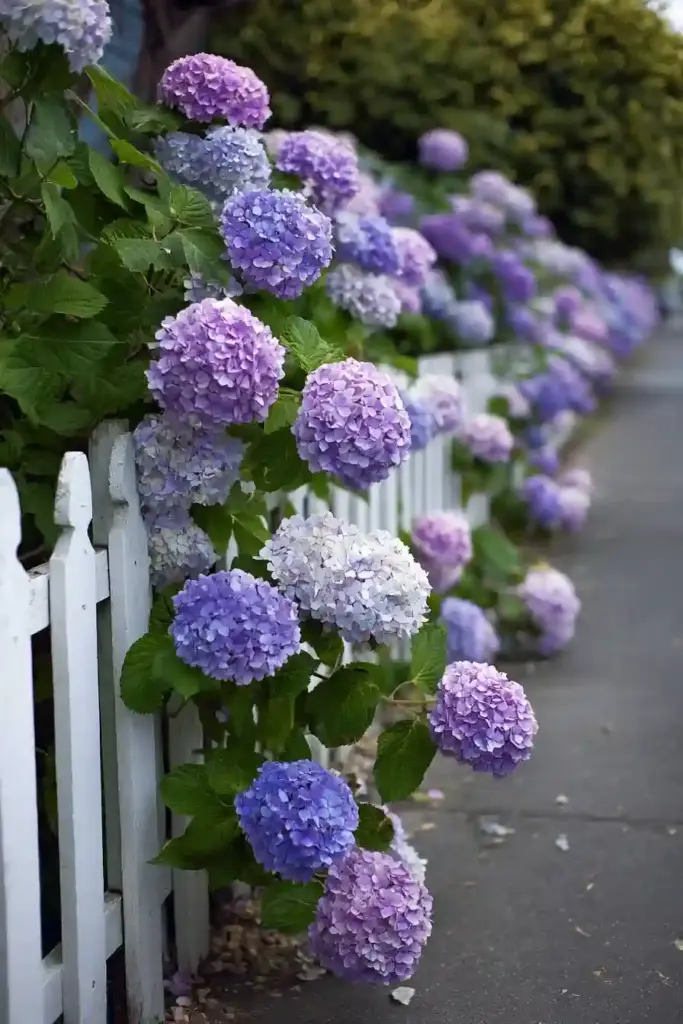
Planting hydrangeas along a fence line is one of the most effective and visually satisfying ways to soften hard boundaries in your garden. These vibrant shrubs help blur the edges of a yard, turning ordinary fences into beautiful backdrops that burst with seasonal color.
Choose varieties based on sunlight conditions—Hydrangea paniculata thrives in full sun, while Hydrangea macrophylla prefers partial shade. For wooden fences, consider white or blue blooms to create a classic coastal or cottage garden look.
Space plants 3 to 5 feet apart, allowing them to grow into a cohesive row without overcrowding. A staggered or zigzag planting pattern can add more depth and dimension. Underplant with low-growing perennials like hostas or geraniums to fill in gaps and create a finished, layered look.
This is one of the most beginner-friendly hydrangea landscaping ideas, offering beauty, privacy, and structure in equal measure.
11. Hydrangea Entrance Archway
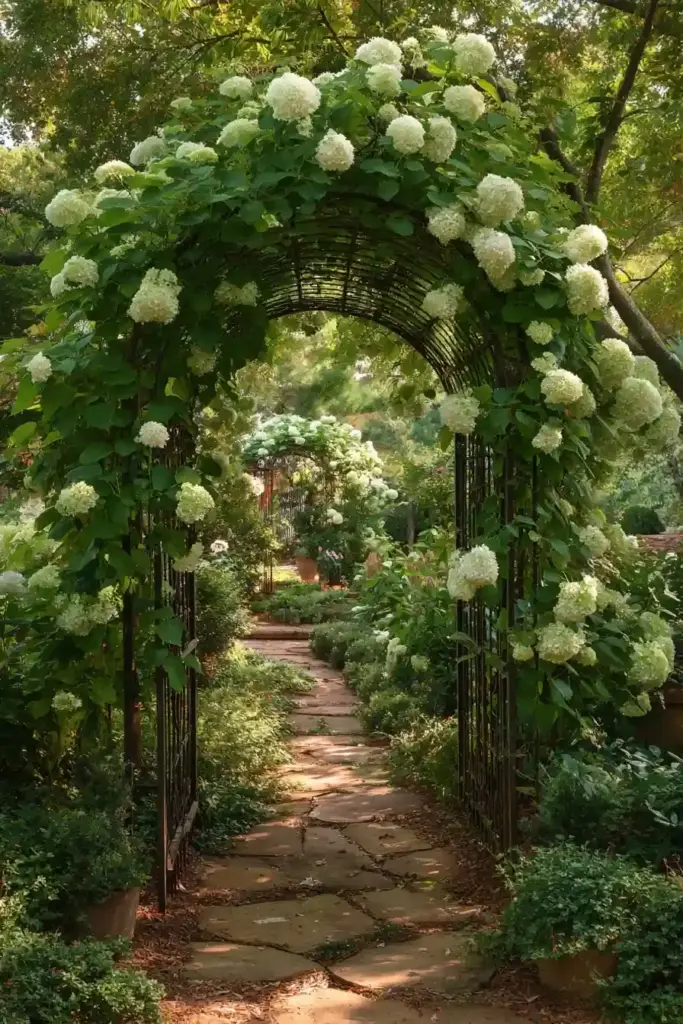
A hydrangea entrance archway adds instant drama and romance to your garden’s entry point. Whether leading into your backyard, garden path, or even your front yard gate, an arch covered in blooming hydrangeas makes a bold, welcoming statement.
Use climbing hydrangeas (Hydrangea anomala subsp. petiolaris) for this setup. These vigorous climbers feature lacy white blooms and can scale trellises, arbors, or archways with ease. Just be patient—climbing hydrangeas take a few seasons to establish but reward you with a lush, cascading display year after year.
Secure the vines with garden ties early on and prune lightly after flowering to shape growth. Pair the archway with shade-tolerant ground cover beneath, like sweet woodruff or creeping Jenny, to keep the look cohesive and full.
Among the most enchanting hydrangea landscaping ideas, this one turns a simple walkway into a garden gateway straight from a fairytale.
12. Hydrangeas in a Rock Garden
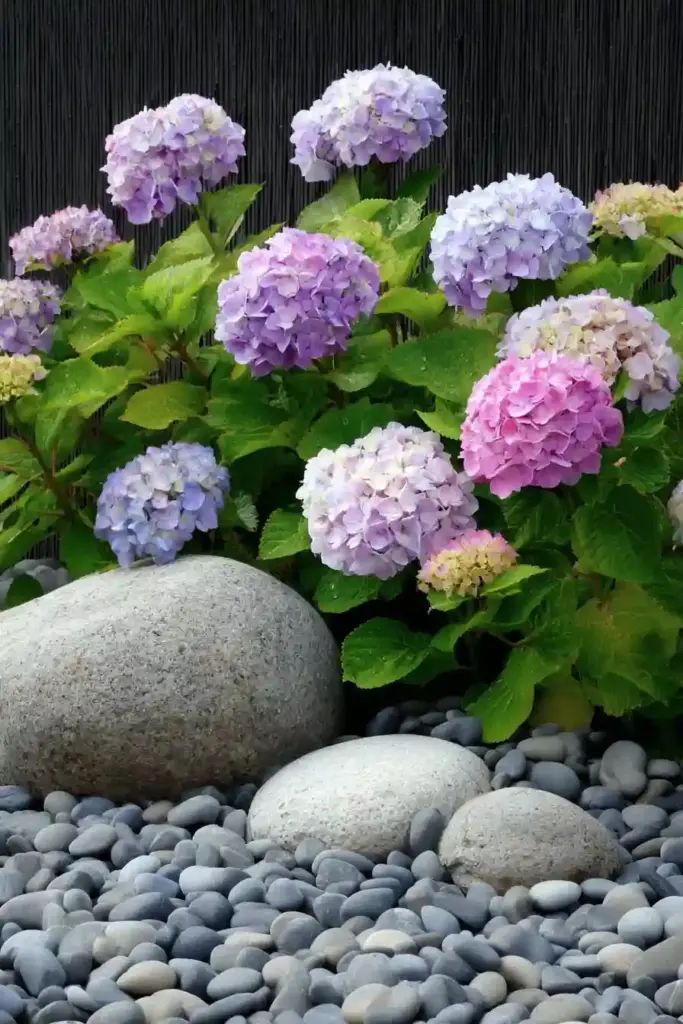
Combining hydrangeas in a rock garden brings a surprising twist to traditional landscaping by contrasting lush, soft blooms with rugged, earthy elements. The result is a modern and artistic space that feels balanced and grounded.
To make this work, choose compact or drought-tolerant hydrangea varieties such as Hydrangea paniculata ‘Little Lime’ or Hydrangea quercifolia, which handle partial sun and leaner soil conditions better than some of their cousins. Position them among large stones or boulders to create pockets of greenery that break up the hard textures.
Use gravel or crushed stone as mulch to enhance drainage and keep a clean look. Accent the space with succulents, ornamental grasses, or low alpine plants for added variety and a layered appearance.
This is one of the most unique hydrangea landscaping ideas, perfect for gardeners who love minimalist designs with a bold focal point.
13. Tiered Hydrangea Flower Bed
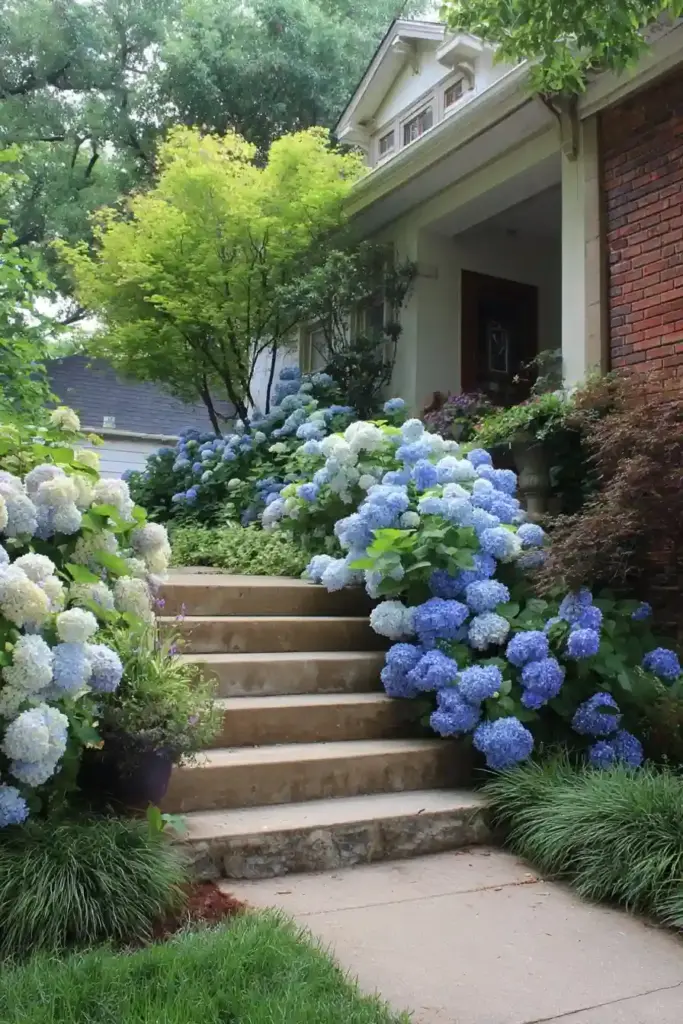
A tiered hydrangea flower bed adds visual height, depth, and drama to any garden space. By arranging plants on multiple levels—whether through raised beds, retaining walls, or natural slopes—you create a layered effect that draws the eye upward and showcases each plant in its best light.
Start with taller varieties like Hydrangea paniculata ‘Phantom’ or Hydrangea arborescens ‘Incrediball’ in the back tier, then work forward with medium-height cultivars and finish with compact options like Hydrangea ‘Little Lime’ at the front. Intersperse with cascading groundcovers or trailing perennials like creeping phlox or alyssum for a softened edge.
This structure works especially well in corner garden beds, along foundations, or on sloped yards that benefit from a more dimensional design.
Among all hydrangea landscaping ideas, this one is perfect for adding architectural interest and ensuring no bloom gets hidden in the crowd.
14. Hydrangeas Surrounding a Water Feature
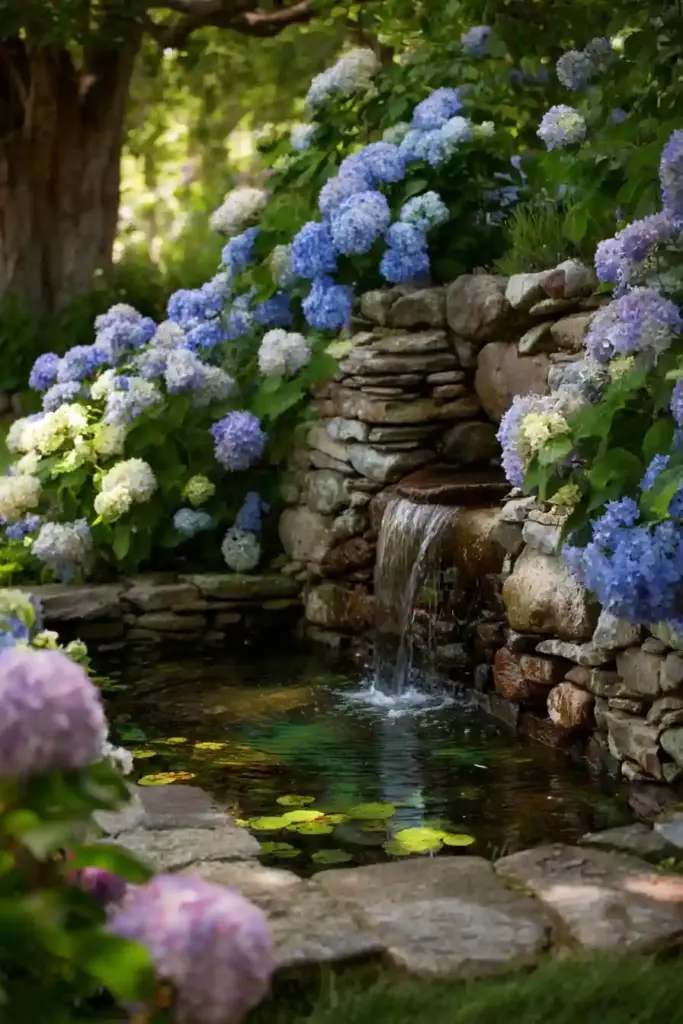
Framing a pond, fountain, or birdbath with blooming hydrangeas is one of the most tranquil hydrangea landscaping ideas, turning an ordinary water feature into a peaceful focal point. The reflection of their blooms on the water adds an extra layer of beauty that evolves with the seasons.
Use varieties that thrive in moist, partially shaded conditions—Hydrangea arborescens and Hydrangea macrophylla are top choices. Plant them a few feet back from the water’s edge to allow airflow and keep roots healthy, while still maintaining their visual impact.
Complement the hydrangeas with plants like iris, astilbe, or hostas to enhance the soft, calming aesthetic. Mulch well and use natural stones around the base to blend the planting into the water feature organically.
This idea doesn’t just beautify your garden—it invites quiet moments of relaxation and attracts pollinators, too.
15. Monochromatic Hydrangea Garden
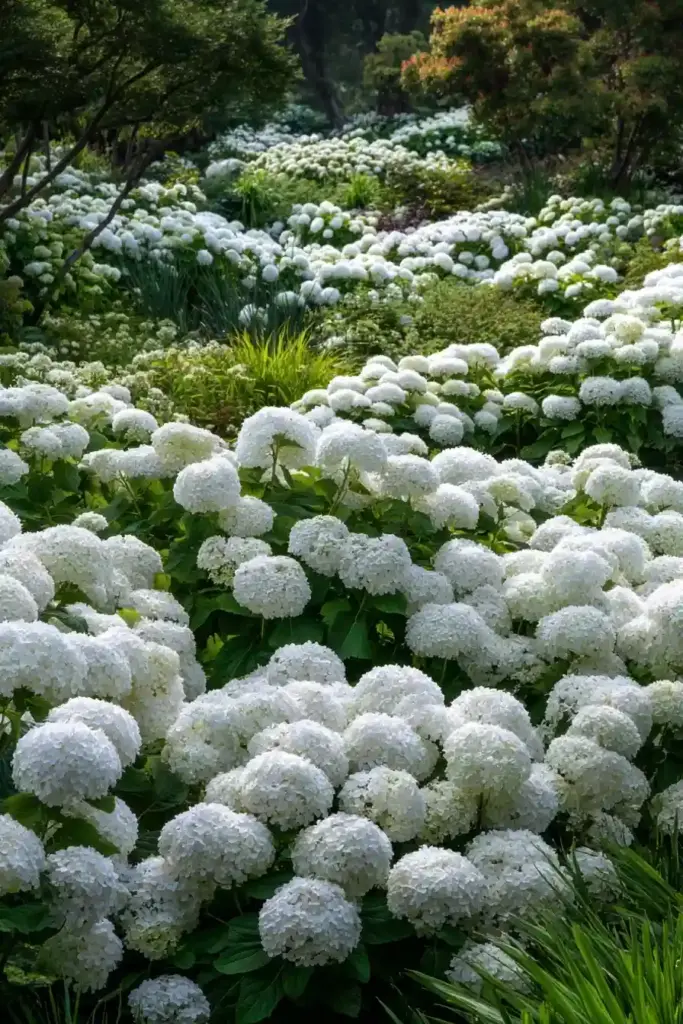
A monochromatic hydrangea garden makes a bold visual statement by focusing on a single bloom color throughout the landscape. Whether you favor soft pinks, bright whites, rich blues, or moody purples, sticking to one palette creates harmony, cohesion, and a calming atmosphere.
To achieve this look, select hydrangea varieties that naturally bloom in your chosen shade—or manipulate bloom color in Hydrangea macrophylla using soil pH. Acidic soil (pH below 6.0) encourages blue blooms, while alkaline conditions (pH above 7.0) yield pinks. For a striking white garden, go with Hydrangea paniculata ‘Pinky Winky’ or Hydrangea arborescens ‘Annabelle’.
Plant in sweeping clusters or curved rows to enhance the effect, and avoid mixing in too many contrasting colors. Instead, add textural variety with ornamental grasses or foliage plants in neutral tones to let the hydrangeas shine.
Among all hydrangea landscaping ideas, this one is minimalist, modern, and effortlessly elegant.
16. Hydrangeas with Ornamental Grasses
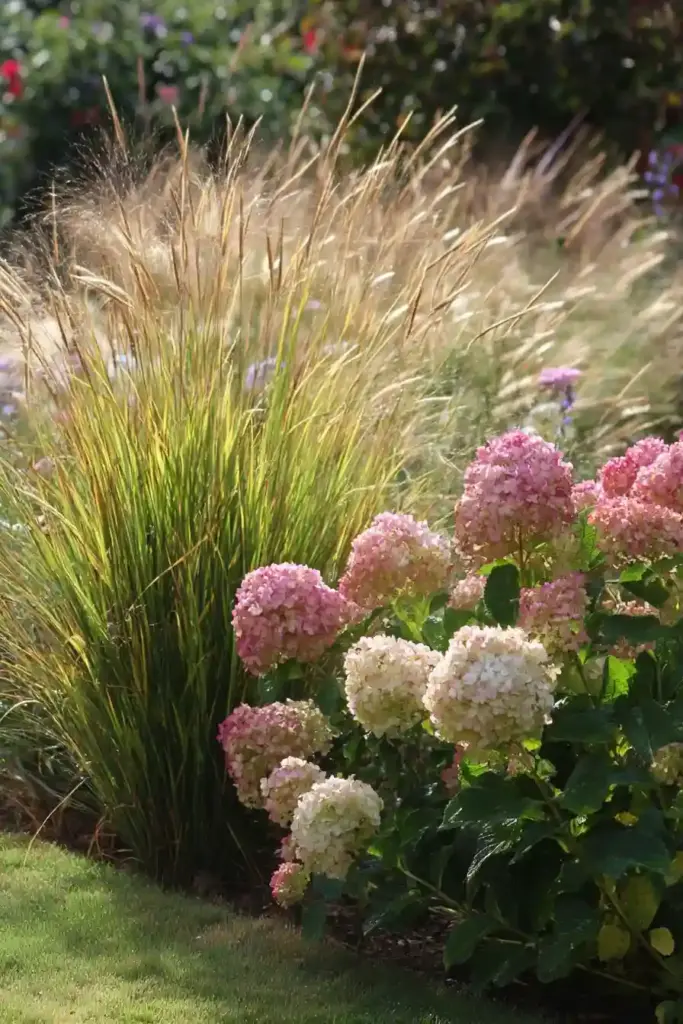
Pairing hydrangeas with ornamental grasses is a modern and eye-catching way to add texture, movement, and contrast to your garden. The structured blooms of hydrangeas stand out beautifully against the soft, swaying blades of grasses, creating a dynamic, layered look that feels both natural and intentional.
Choose grasses like miscanthus, fountain grass, or blue fescue to complement the height and density of hydrangea varieties such as ‘Limelight’, ‘Annabelle’, or ‘Little Lime’. This combination works particularly well in mixed borders, around patios, or in larger beds where you want year-round interest.
Grasses add winter structure when hydrangeas go dormant, while hydrangeas provide the show-stopping blooms in summer and early fall. Use mulch to unify the bed visually and help retain moisture for both plant types.
This is one of the most balanced hydrangea landscaping ideas, perfect for gardeners who appreciate both beauty and low-maintenance design.
17. Hydrangea Island Bed in a Lawn

Creating a hydrangea island bed in a lawn is a powerful way to transform open grassy areas into vibrant focal points. By isolating a group of hydrangeas in the center of your yard, you immediately draw the eye and break up the monotony of flat green space.
Start by choosing a rounded or oval shape for the bed, and plant 3–5 hydrangeas in staggered clusters for natural movement. Use taller varieties like ‘Limelight’ or ‘Phantom’ in the center, and surround them with lower plants like boxwood, salvia, or daylilies for contrast and seasonal interest.
Edge the bed with bricks, natural stone, or steel to give it definition, and mulch generously to keep the design tidy and low-maintenance. This arrangement works beautifully in large front yards or backyard lawns where you want to introduce structure without hardscaping.
As hydrangea landscaping ideas go, this one delivers big visual impact with relatively little effort.
18. Hydrangeas Flanking a Pathway
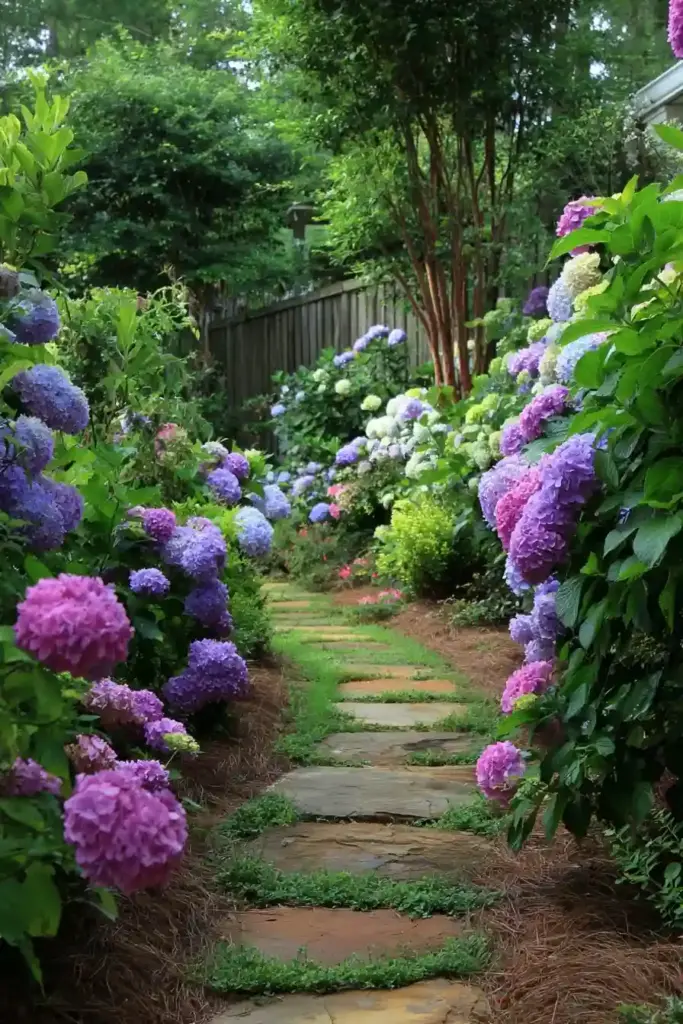
Lining a garden path with blooming hydrangeas is one of the most enchanting hydrangea landscaping ideas, guiding guests through your outdoor space with bursts of seasonal color. The large, rounded blooms naturally create a sense of rhythm and movement as you walk, while adding softness to stone, gravel, or brick walkways.
Choose compact or mid-size hydrangea varieties like ‘Little Lime’, ‘Tuff Stuff’, or ‘Bobo’ to avoid crowding the path. Plant them in evenly spaced pairs on either side for a symmetrical, formal look—or stagger them for a more relaxed, organic feel.
Underplant with low-profile perennials such as lamium, creeping thyme, or heuchera to add texture and fill in the gaps without overpowering the hydrangeas.
This approach works beautifully in both modern and cottage-style gardens, offering both structure and softness while making every stroll through your yard feel intentional and memorable.
19. Hydrangea Planter Box Under Windows

Installing a hydrangea planter box under windows is a simple yet high-impact way to merge your home’s architecture with natural beauty. The cascading blooms bring softness and seasonal color right up to your house, creating a warm, cottage-style curb appeal.
Choose compact hydrangea cultivars like ‘Cityline Paris’, ‘Mini Penny’, or ‘Little Lime’, which are well-suited for containers and won’t overwhelm the window space. Ensure your planter boxes are deep enough—at least 12–18 inches—to support healthy root growth and have proper drainage to prevent rot.
Use a high-quality potting mix and water regularly, especially during dry spells. Mix in trailing plants like ivy, sweet potato vine, or lobelia to spill over the edges and create a lush, overflowing effect.
This is one of the most space-efficient hydrangea landscaping ideas, perfect for urban homes, small gardens, or anyone wanting to add floral charm without needing extra ground space.
20. Hydrangeas Paired with Perennials like Hostas and Ferns
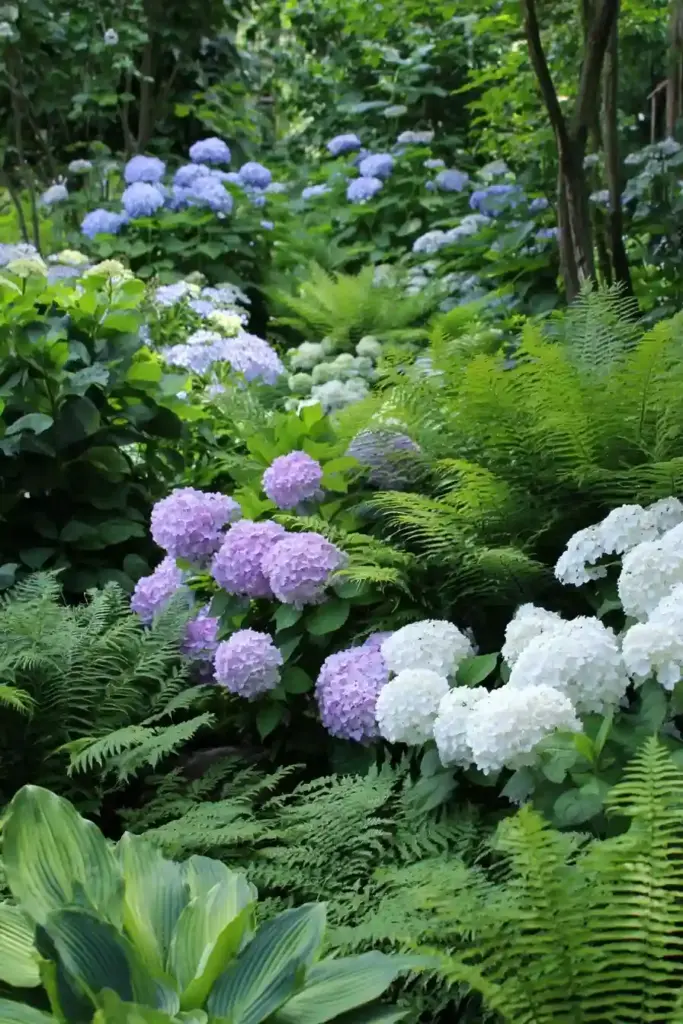
One of the most harmonious hydrangea landscaping ideas is pairing hydrangeas with classic shade-loving perennials like hostas and ferns. This trio creates an easy, lush, and layered look, bringing together bold blooms, dramatic foliage, and soft textures in shaded or partially shaded garden beds.
Hydrangeas provide vibrant flowers and sturdy structure, while hostas contribute broad, architectural leaves in shades of green, blue, and variegated white. Ferns add an airy, delicate touch that lightens up the composition. All three plants thrive in similar soil and moisture conditions, making care simple and maintenance minimal.
Arrange hydrangeas toward the back or center of a bed, with hostas and ferns around the edges for a natural, cascading effect. Fill in gaps with woodland bulbs or groundcovers for even more interest. This approach works beautifully along house foundations, under mature trees, or in north-facing gardens where sunlight is limited.
It’s a timeless combination that delivers season-long beauty and texture with very little fuss.
author:Conclusion
Hydrangea landscaping ideas offer something for every garden—no matter its size, style, or sun exposure. From borders and hedges to vibrant container displays and tranquil woodland scenes, these versatile shrubs make it easy to create a landscape that feels both welcoming and strikingly beautiful.
Whether you’re looking to soften a fence line, brighten a patio, or build a serene focal point, hydrangeas deliver season after season. By mixing them with evergreens, grasses, roses, or shade-loving perennials, you can design a space that’s uniquely yours and thrives with minimal maintenance.
Experiment with these ideas, and don’t hesitate to let your personal taste and creativity guide you. With hydrangeas, it’s hard to go wrong.
🌿 Love gardening inspiration? Follow me on Pinterest for bold plant ideas, tips, and seasonal color!
More Posts
